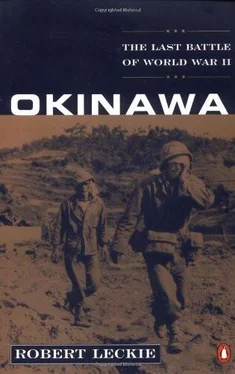“From Okinawa,” one lieutenant told his platoon, “we can bomb the Japs anywhere—China, Japan, Formosa …”
“Yeah,” a sergeant mumbled, “and vice versa.”
It was true, of course, that the Japanese had sixty-five airfields on Formosa to the south and fifty-five on Kyushu to the north, as well as a few dozen scattered throughout the southern Ryukyus, but such discouraging information is not normally disseminated among the troops. More pointed and helpful information came from veterans such as Corporal Al Biscansin of the Sixth Marine Division, who offered this earnest advice to the boots:
“When you aren’t moving up or firing, keep both ends down! The GI Bill of Rights don’t mean a thing to a dead Marine.”
The GI Bill rivaled the habu as a topic of conversation, for a surprising number of these young men intended to go to college when the war was over. They even expected that great event to happen soon.
“Home alive in ‘45,” they said, a happy revision of Guadalcanal’s gloomy estimate of “the Golden Gate in ’48.” They sang “Good-bye, Mama, I’m off to Okinawa,” and joked about the latest horrendous estimates of American disaster broadcast by Radio Tokyo.
Admiral Ugaki had already made the mistake of believing that his airmen had crippled Spruance’s fleet in those mid-March attacks and seriously delayed invasion of Okinawa. Because of his error, the Kerama Islands landings caught the Japanese unprepared. Only Ushijima’s handful of obsolete crates on Okinawa and a few kamikaze from Kyushu were able to intervene, but they inflicted only slight damage. Yet, on March 28, the GIs and Marines aboard the transports heard Radio Tokyo announce the sinking of a battleship, six cruisers, seven destroyers, and one minesweeper, and then the voice of an American-educated announcer simpering:
This is the Zero Hour, boys. It is broadcast for all you American fighting men in the Pacific, particularly those standing off the shores of Okinawa … because many of you will never hear another program … Here’s a good number, “Going Home” … it’s nice work if you can get it … You boys off Okinawa listen and enjoy it while you can, because when you’re dead you’re a long time dead … Let’s have a little jukebox music for the boys and make it hot…. The boys are going to catch hell soon, and they might as well get used to the heat …
Then, having described the varieties of death instantly impending for “the boys off Okinawa,” the voice concluded: “Don’t fail to tune in again tomorrow night.”
Two days later the voice was somber. “Ten American battleships, six cruisers, ten destroyers, and two transports have been sunk. The American people did not want this war, but the authorities told them it would take only a short while and would result in a higher standard of living. But the life of the average American citizen is becoming harder and harder and the war is far from won…”
On March 31 the assault troops were given an eve-of-battle feast. “We had a huge turkey dinner,” the famous war correspondent Ernie Pyle reported. “ ‘Fattening us up for the kill,’ the boys said.”
The next day Radio Tokyo had lost its audience: “The boys off Okinawa” had gone ashore.
That was on April 1—Easter Sunday, 1945, April Fool’s Day, or L day, as it was called officially. The L stood for “Landing,” but the Americans who hit the Hagushi Beaches with hardly a hand raised to oppose them had another name for it.
They called it Love Day.
At 4:06 A.M. April 1, 1945, beneath still-darkened skies, Vice Admiral Richmond Kelly Turner aboard his flagship El Dorado gave the expeditionary force commander’s traditional order: “Land the landing force!” Forty-five minutes later with the break of dawn the American bombardment force began firing that howling “typhoon of steel” that drove most terrified Okinawans into their storm caves and shook even those Japanese defenders—resolute moles that they were—deep inside their hollowed-out hills, caverns, concealed pillboxes, camouflaged blockhouses, and fortified lyre-shaped tombs.
Along eight miles of beaches ten battleships were firing, their huge turret guns ranging from twelve to sixteen inches in their bore diameter, hurling spinning shells weighing from twelve hundred to eighteen hundred pounds. Most of these battlewagons were obsolete, and some had been raised from the floor of Battleship Row at Pearl Harbor and been rebuilt. The ancient Arkansas had been commissioned well before World War I and had been ready for the scrap heap until Pearl Harbor Day kept her afloat. There they were: flagship Tennessee, Colorado, Idaho, New Mexico, Texas, New York, West Virginia, Nevada, and, of course, Arkansas. Most of them shared a common defect: they were too slow to keep up with the modern fast carriers, and so had been refitted for shore bombardment. Normally, battleships fought other ships, firing armor-piercing shells on flat trajectories, but these off Okinawa had been adjusted to high-angle fire of high explosives strong and heavy enough to pierce and shatter enemy emplacements, and sometimes even to strike reverse slopes.
Interspersed in the gaps between the battlewagons, like the fingers of smaller hands fitted into those of bigger ones, were nine prewar heavy cruisers—veterans of every Pacific preinvasion bombardment. Joining them were three light cruisers and twenty-three destroyers, as well as dozens of those landing craft infantry (LCIs) that had been found too awkward for their designed mission of plowing up on enemy beaches and so converted to rocket fire. Americans boated in the amtracks following the rocket ships “in” cheered lustily when they heard that monster swoooosh! of those flights of missiles darkening the skies like so many arrows from thousands of bows.
Spruance’s Fifth Fleet, besides the striking power of his TF 58 and the flying buffer of the British carrier force, also included ninety minesweepers of all types ready to clear Okinawan waters of the primitive contact mines planted by the enemy. There were also the brave SEALS, as they are now called, of the Navy’s Underwater Demolition Teams, charged with detonating the enemy’s underwater explosives and pointed stakes; the big bombers of the Twentieth Air Force, and the Tenth Army’s own Tactical Air Force made up mostly of Marine pilots and commanded by a Marine, Major General Francis Mulcahy.
Here, off those eight miles of Hagushi Beaches, the heaviest weight of metal ever hurled from sea to shore was clearing the way for the assault troops—and yet, it was never needed. For all their thunder and flash, their geysering flame and smoke like so many erupting volcanos, the bombardment was falling harmlessly among beaches, hills, and valleys long ago abandoned by General Ushijima.
Even Ushijima and his staff standing atop Shuri Castle and studying the scene through binoculars were deeply impressed. One of these officers later wrote in his diary that the flash and crash of this incredible bombardment was “a scene of unsurpassed grandeur.” They were also glad that Ushijima had accepted Yahara’s advice not to defend the Hagushi Beaches. From what they saw they could imagine the carnage among their troops if he had adhered to the old, discredited doctrine of “destruction at the water’s edge.”
Yet for all its negligible effects, the titanic sea bombardment would serve one major psychological purpose: it would encourage the assault troops. Boated in their amphibious tractors—“amtracks” —in the bellies of their LSTs—“Landing Ship, Tanks,” which they derisively called “Large Stationary Targets”—these men had been swallowing the smoke of their roaring vehicles for hours. Lined up on the tank deck two abreast, nose to rear, it was as though they were in a traffic jam, or sailing to battle in the Lincoln Tunnel. All—even the veterans—were tense and fearful, for they had been told that Okinawa would not be easy. Among some of the Marines it was more than anxiety that tied their stomachs in knots. They had breakfasted on “styke ’n’ aiggs,” a tradition they had picked up in Australia and New Zealand, and were having difficulty holding it down. Some ship’s doctors hoped that they would all let it go over the side, once they were seaborne. “Steak and eggs!” one dismayed surgeon had cried. “A nice lot of guts that’ll be to sew up—full of steak!”
Читать дальше










